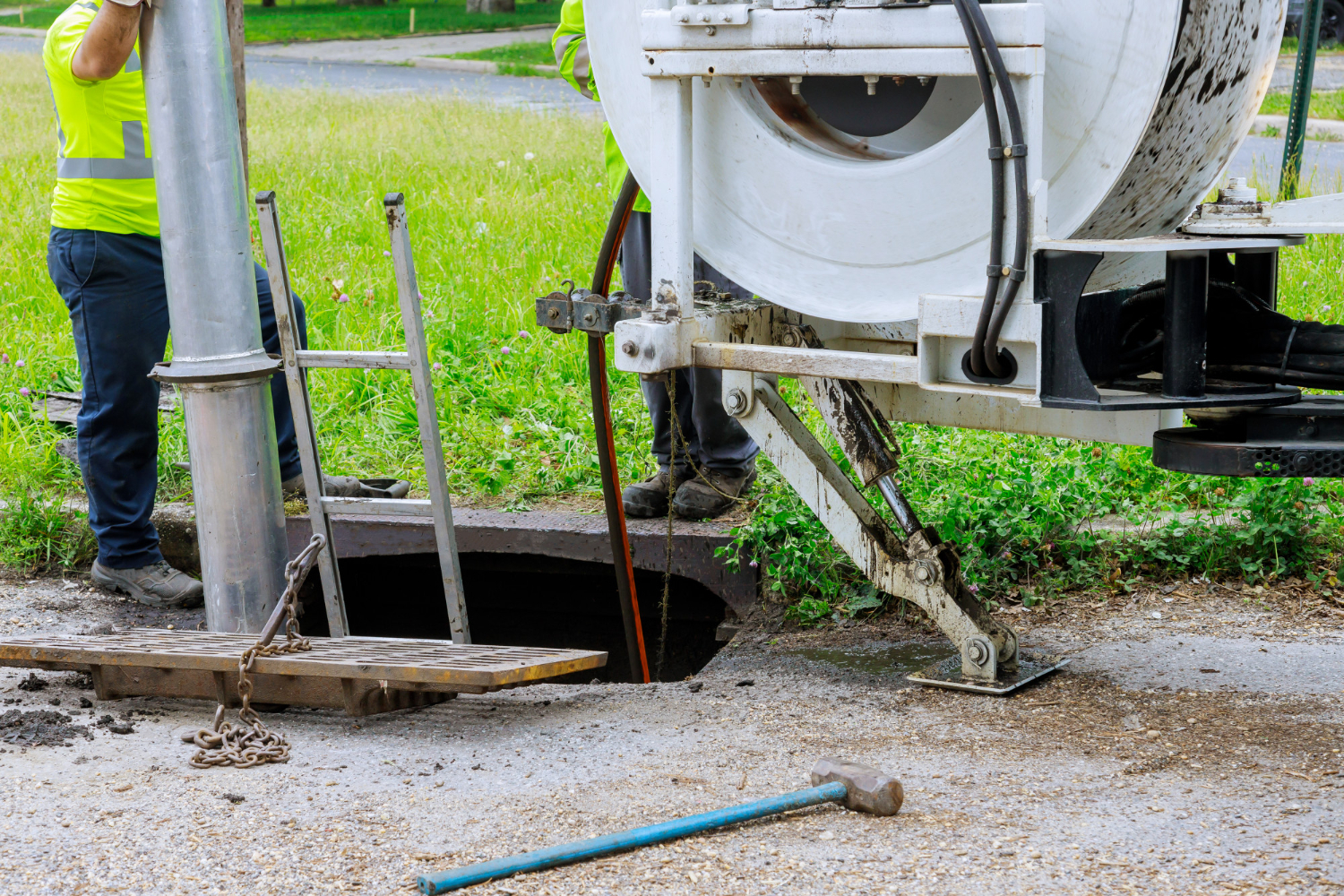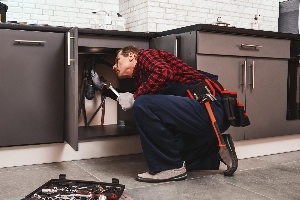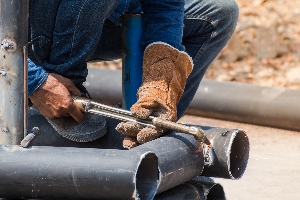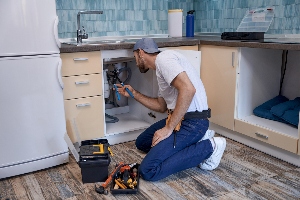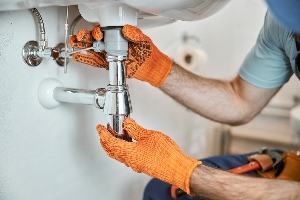Professional sewer rodding services can clear most blockages within hours using specialized equipment that reaches deep into pipes where household tools cannot. This proven method handles everything from grease buildup to root intrusions that completely stop water flow.
When drains back up or sewers overflow, homeowners need fast solutions that actually work. Sewer rodding uses flexible metal cables with cutting heads to break through tough blockages that cause these messy, urgent problems.
We'll explore how this process works, what it costs, and how to find reliable professionals in the Spartanburg and Greenville areas. You'll also learn when rodding might not be enough and what alternatives exist for severe pipe damage.
Here's what you need to know:
- How sewer rodding restores flow to blocked drains and sewer lines
- Understanding the cost of sewer rodding
- How often to schedule sewer rodding for long-term prevention
- When sewer rodding isn't enough
- Choosing the right sewer rodding service in Spartanburg and Greenville
By the end, you'll know how sewer rodding service clears tough blockages, when it’s the right choice over jetting, and what it typically costs in Spartanburg & Greenville.
How sewer rodding restores flow to blocked drains and sewer lines
Sewer rodding uses specialized equipment to break through stubborn blockages that trap water and waste in your pipes. The mechanical process targets clogs directly at their source and works faster than chemical solutions.
How the sewer rodding process works from start to finish
We start by locating the main access point to your sewer lines. Our technicians insert flexible rods into the pipes through cleanouts or other entry points.
The rods connect together to reach deep into your sewer system. We can extend them hundreds of feet if needed to reach distant blockages.
The cutting head does the main work:
- Rotating blades break apart tree roots
- Sharp edges cut through grease buildup
- Scraping action removes stuck debris
As we push the rod forward, the spinning head chops up whatever blocks the pipe. Water flow carries the broken pieces away from the area.
We test water flow after clearing each section. This helps us know when we have removed the entire blockage. The process continues until water moves freely through all affected pipes.
Why rodding is more effective than chemical drain cleaners
Chemical drain cleaners cannot reach many types of clogs in sewer lines. They work only on soft materials near the surface of pipes.
Rodding handles tough blockages that chemicals cannot:
- Tree roots that grow into pipes
- Hardened grease and soap buildup
- Foreign objects stuck in lines
- Mineral deposits on pipe walls
According to the U.S. EPA, tree roots can create stoppages and damage sewer lines, and fats, oils, and grease (FOG) can partially block or clog pipes, reinforcing the need for regular cleaning/maintenance programs
The mechanical action cuts through solid obstructions. Chemicals often flow around hard clogs without breaking them up.
We apply force directly where the blockage sits. This targeted approach clears the entire width of the pipe. Chemical solutions may only create small channels through clogs.
Rodding also cleans pipe walls as we work. This removes buildup that could cause future problems.
Common signs your home needs a drainage rodding service
Multiple drains backing up at once means your main sewer line has a blockage. This requires professional rodding equipment to clear.
Watch for these warning signs:
- Water backing up in floor drains
- Gurgling sounds from toilets or drains
- Sewage odors coming from drains
- Slow drainage in multiple fixtures
Tree roots cause many sewer line problems. We see this most often in older homes with clay or cast iron pipes.
Recurring clogs in the same area suggest a partial blockage. Standard drain cleaning may provide temporary relief, but rodding removes the entire obstruction.
Grease buildup creates stubborn blockages in kitchen drain lines. Regular use of garbage disposals makes this problem worse over time.
Understanding the cost of sewer rodding
Professional sewer rodding typically costs between $200 and $600 for most residential jobs. The final price depends on how severe your blockage is and what factors complicate the work.
Average sewer rodding cost for residential properties
Most homeowners pay $200 to $600 for professional sewer rodding services. This range covers standard blockages in typical residential sewer lines.
According to Forbes Home, snaking a sewer line typically costs $200–$600, while hydro-jet drain cleaning runs about $300–$1,000, depending on access and clog severity.
Simple clogs near the surface usually cost around $200 to $300. More complex blockages deeper in your system can reach $400 to $600.
Emergency calls during nights or weekends often add $100 to $200 to your total bill. We recommend scheduling service during regular business hours when possible to save money.
The cost may seem high, but it prevents much bigger problems. A major sewer backup can cost thousands of dollars to repair and clean up.
How much a standard drain rodding service costs
A basic drain rodding service for your home typically runs $250 to $400. This covers most common blockages like grease buildup, debris, or small root intrusions.
The service includes bringing rodding equipment to your property and clearing the main blockage. Most companies also do a basic inspection to check for other issues.
Some contractors charge by the hour at $150 to $200 per hour. Others use flat-rate pricing based on the type of blockage they find.
You should get a clear estimate before work begins. Ask if the price includes cleanup and what happens if they find additional problems.
Factors that can raise or lower your total bill
Several factors affect your final sewer rodding cost:
Location of the blockage matters most. Clogs near your house cost less than blockages far out in your yard.
Severity of the blockage changes the price significantly. Tree roots and hardened grease take more time and effort to clear.
Age of your pipes can increase costs if older materials are fragile or damaged.
Access to your sewer line affects pricing. Easy access keeps costs down while difficult-to-reach pipes cost more.
Time of service impacts your bill. Regular business hours cost less than emergency weekend calls.
Additional services like video inspections or pipe repairs add to your total cost.
How often to schedule sewer rodding for long-term prevention
Regular maintenance schedule planning prevents costly emergency repairs and keeps sewer lines flowing smoothly. Most homes benefit from rodding every 18 to 24 months, though timing depends on your property's specific conditions and seasonal factors.
Why regular rodding keeps major blockages from forming
Regular rodding removes small debris before it becomes a major problem. When we wait too long between services, tree roots grow deeper into pipes and grease builds up in thick layers.
Small blockages turn into complete pipe closures over time. A maintenance schedule prevents this by clearing away:
- Tree root intrusions before they spread
- Grease buildup that attracts other debris
- Sediment deposits that narrow pipe diameter
- Foreign objects stuck in bends and joints
Preventative rodding costs between $200 and $600. Emergency repairs can cost thousands when pipes back up or burst.
We recommend rodding every 18 to 24 months for most homes. Properties with mature trees or heavy grease use need more frequent service.
Regular maintenance also extends your sewer system's lifespan. Clean pipes experience less corrosion and structural damage than clogged ones.
How seasonal changes can impact your sewer line health
Seasonal changes create different challenges for sewer line health throughout the year. Spring brings the most problems as tree roots actively seek water sources.
Spring and summer present these risks:
- Tree roots grow rapidly toward sewer lines
- Heavy rains can wash debris into systems
- Outdoor activities increase foreign object risks
Fall challenges include:
- Leaves and organic matter entering drain openings
- Root systems preparing for winter by expanding
- Ground settling that can shift pipe connections
Winter issues involve:
- Frozen ground that prevents proper drainage
- Holiday cooking that increases grease disposal
- Reduced bacterial activity in septic systems
We schedule rodding based on these seasonal patterns. Spring cleaning works best for most properties since it removes winter buildup before summer growth begins.
Properties in areas with heavy tree coverage benefit from fall rodding too. This prevents root problems during winter months when access becomes more difficult.
When to combine rodding with other preventative maintenance
Combining rodding with other preventative maintenance creates the most effective sewer line care program. Camera inspections work well with rodding to identify problem areas.
Best maintenance combinations include:
- Rodding + camera inspection for complete assessment
- Rodding + hydro jetting for stubborn buildup
- Rodding + root treatment chemicals for tree-heavy areas
We recommend camera inspections every 2-3 years alongside regular rodding. This shows pipe condition and identifies weak spots before they fail.
Hydro jetting works better than rodding alone for grease-heavy blockages. Restaurants and homes with frequent cooking benefit from this combination.
Root treatment chemicals extend time between rodding services. We apply these after clearing existing roots to prevent quick regrowth.
Timing combinations effectively:
- Spring: Rodding + root treatment
- Summer: Camera inspection + minor repairs
- Fall: Preventative rodding for winter prep
This schedule catches problems early while maintaining steady sewer line health year-round.
When sewer rodding isn't enough
Sometimes rodding only provides a temporary fix when deeper structural problems exist in your sewer lines. Complex issues like root intrusion or collapsed pipes require more than basic clearing techniques to restore proper drainage.
Situations where rodded drains need additional repairs
We see cases where rodding clears the immediate blockage but doesn't solve the root cause. Tree roots can break through pipe joints and grow into the line. The rodding process removes debris but leaves the entry points open.
Cracked or broken pipes create ongoing problems. Water leaks out and soil washes in. This creates new blockages within weeks or months.
Common signs your drain needs more than rodding:
- Blockages return quickly after clearing
- Water backs up in multiple drains
- Wet spots appear in your yard
- Bad smells come from drains
Older pipes made of clay or cast iron often have structural damage. The pipe walls may be thin or joints separated. Rodding can actually make these problems worse by applying pressure to weak spots.
How to spot deeper issues like root intrusion or collapsed pipes
Root intrusion shows specific warning signs we can identify. You'll notice slow drains that get worse during spring and summer when trees grow actively. Gurgling sounds often happen when roots block normal water flow.
We look for these root intrusion symptoms:
- Seasonal patterns - Problems worse in growing season
- Location matters - Issues near large trees or shrubs
- Multiple fixtures - Several drains affected at once
Collapsed pipes create different symptoms. Water may pool in your basement or crawl space. You might see sinkholes or soft spots in your lawn where pipes have failed underground.
Collapsed pipe warning signs:
- Sudden complete blockages
- Foundation settling or cracks
- Unusually green grass patches
- Sewer odors outside your home
These problems need immediate attention. Waiting makes repairs more expensive and causes property damage.
Why a professional inspection matters before costly repairs
We use camera inspections to see inside your pipes before recommending expensive work. A small waterproof camera travels through the sewer line and shows us exactly what's wrong.
This inspection reveals the true condition of your pipes. We can tell if rodding will work or if you need pipe replacement. The camera shows root locations, crack sizes, and pipe material condition.
Benefits of professional inspection:
- Accurate diagnosis saves money
- No guessing about repair needs
- Video evidence of problems
- Prevents unnecessary work
Many homeowners spend money on repeated rodding when they really need targeted repairs. We've seen cases where $200 in rodding happens monthly because the real problem costs $2,000 to fix properly.
The inspection typically costs $200-400 but prevents thousands in wrong repairs. We can show you exactly where problems exist and explain the best solution for your specific situation.
Choosing the right sewer rodding service in Spartanburg and Greenville
Finding the right drainage rodding contractor requires checking their credentials, asking specific questions about their methods and pricing, and choosing local professionals who understand the unique plumbing challenges in our region.
What to look for in a reliable drainage rodding contractor
Proper licensing and insurance should be our first priority when selecting a sewer rodding service. All legitimate contractors in South Carolina must carry state licenses and liability insurance.
We should verify their 24/7 emergency availability. Sewer blockages don't wait for business hours. The best rodding professionals offer round-the-clock service to handle urgent situations.
Equipment quality matters significantly. Professional contractors use industrial-grade rodding machines and cameras to locate blockages accurately. They should have different rod sizes for various pipe diameters.
Look for contractors who provide written estimates before starting work. Reliable services explain their pricing structure clearly and avoid surprise charges.
Customer reviews and references tell us about real experiences. We should check online ratings and ask for recent customer contacts to verify their work quality.
Questions to ask before hiring a rodding professional
"What specific equipment do you use?" Professional services should explain their rodding machines, camera inspection tools, and cleaning methods. Modern equipment clears blockages more effectively than outdated tools.
"Can you provide a detailed written estimate?" This should include labor costs, equipment fees, and any additional charges. Professional contractors explain their pricing upfront without hidden fees.
"How long will the job take?" Experienced rodding professionals can estimate timeframes based on the blockage severity and pipe condition.
"Do you offer any guarantees on your work?" Quality services stand behind their results with warranties on cleared blockages.
"Are you licensed and insured in South Carolina?" We should always verify these credentials before hiring any contractor.
How local expertise ensures faster, more effective results
Local contractors understand regional pipe systems common in Spartanburg and Greenville homes. They know which materials and installation methods were used in different neighborhoods and time periods.
Soil conditions in our area affect sewer line problems. Local rodding professionals recognize how clay soil and tree root patterns create specific blockage types in our region.
Faster response times come from nearby locations. Local services reach emergency calls quicker than distant companies, preventing water damage and further complications.
Established relationships with local suppliers mean faster equipment repairs and replacement parts. This keeps their tools working properly for our jobs.
Weather knowledge helps local experts plan work around seasonal challenges like heavy rains or freezing temperatures that affect sewer systems differently here.
Conclusion
Sewer rodding services provide fast and effective solutions for tough blockages in your plumbing system. These professionals use specialized equipment to clear stubborn clogs that regular methods cannot handle.
When we face serious drainage problems, calling experts saves time and money. Professional rodding prevents costly repairs and extends our plumbing system's lifespan.
We should contact licensed plumbing professionals when we notice slow drains or sewage backups. These warning signs indicate blockages that need immediate attention.
Regular maintenance through professional rodding keeps our sewer lines healthy. This proactive approach helps us avoid emergency situations and expensive repairs.
Schedule your sewer rodding service with One Call Plumbing today, request a same-day camera inspection and blockage removal with clear, upfront pricing in Spartanburg & Greenville.

